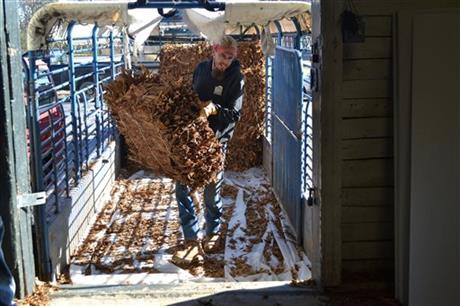
By BRUCE SCHREINER
Tripp Foy’s sing-song chant rang out like a sentimental oldie for die-hard farmers clinging to the old way of selling tobacco, as a small procession of buyers shadowed him down long rows of reddish-brown leaf piled in bales.
Farmers who have spent their lives tending the aromatic crop in their fields find comfort in Foy’s rat-a-tat style, part of an auction system that’s been all but snuffed out by another way of selling tobacco after years of declining smoking rates.
“It’s kind of in our blood,” said tobacco farmer Walter Browning. “But I’m about bled out.”
This tobacco-belt tradition, once as much a part of Kentucky’s fabric as bourbon or horse racing, is fading away — and it’s taking the maestros like Foy with it.
“The chant of an auctioneer can sound as good as a song,” said Foy, 63, who has spent four decades auctioning tobacco in Kentucky — the nation’s top burley producer. “You can walk down a row and you can almost dance to the tune of the sale.”
Years ago, multiple auctioneers plied their trade in each of the state’s biggest burley markets as sales seasons typically stretched from late autumn until March. The competition for top auctioneers was fierce as warehouse operators looked for any edge to pull in more business from farmers.
Now, most burley is sold under contracts between farmers and tobacco companies. Contracting sprung up a decade ago after the demise of a federal program of price supports and production quotas that guaranteed minimum prices for most of the 20th century.
The new system cut out warehouse operators as middle men.
Tobacco companies typically don’t disclose how much contract leaf they purchase or for how much to avoid tipping their hand to competitors.
Excess world burley tobacco supplies and lower demand are driving down prices, said University of Kentucky agricultural economist Will Snell.
Last year’s crop averaged $2.06 per pound. Quality leaf sold under contract is still fetching prices in the $1.90s to $2 a pound this season, he said. But selling non-contract burley, especially lower-quality leaf, is “going to be a struggle,” he said.
Droves of farmers got out of tobacco as U.S. smoking rates declined. The number of U.S. tobacco farms dropped from 124,270 in 1992 to 16,234 during the last federal crop census in 2007. Burley, once a $1 billion crop in Kentucky, now generates about $300 million for the state’s remaining growers.
Despite the setbacks, a handful of auction markets have stubbornly hung on.
Supporters say they provide a necessary alternative for tobacco farmers unable or unwilling to sign contracts or unhappy with prices offered by the companies at contract receiving stations.
About 400,000 pounds of tobacco were available last month on the opening sales day at the Danville warehouse, where Foy presided as auctioneer. Jerry Rankin, the warehouse operator, plans twice-weekly auctions for larger supplies of non-contract leaf. Rankin bought up some of the burley when bidding by leaf dealers was too low. Rankin bought it on speculation, hoping to sell it to tobacco companies or dealers. He expects all the leaf to wind up in cigarettes.
Total output in burley-production states is forecast at 211 million pounds this year, with Kentucky accounting for an expected 161 million pounds.
Some Kentucky farmers found out in the spring they had been dropped from production contracts, after buying tobacco plants and preparing ground, Rankin said. They went ahead with the crop, putting millions more pounds of leaf in the auction system at a time when demand and prices are depressed.
“These growers grew it in good faith and did a good job doing it, and they’re spinning their wheels,” Rankin said. “Some of them are going to go under.”
Other than Foy’s familiar chant, little else resembled opening days from the era when every bit of leaf went through the auction system.
Grim-faced growers watched their burley sell for paltry amounts — generally $1.25 or $1.30 a pound.
“It’s a sad day,” said farmer Leland Turner. “I never thought I’d see the time when tobacco would be so cheap.”
Prices improved slightly in follow-up sales at the Danville warehouse, to an average of $1.35 to $1.44 per pound, Rankin said. But that’s not nearly enough to cover expenses for the crop, unless farmers and their families did all the work themselves.
Years ago, the auctions signaled the promise of money filtering through small towns and big cities alike.
For farmers, it was the anticipation of a big pay day. If early prices were good enough, the payoff came right before Christmas. Bankers and merchants kept tabs on how high the bidding went.
There was no festive mood as this year’s sales opened at the Danville warehouse. An ag credit lending agency supplied doughnuts for the few dozen people on hand. Rankin gave a short speech, thanking the farmers for their business.
For some of the growers looking on, the end of the line was coming into focus.
Browning said he already decided this year’s crop would be his last. He has a factory job and used his tobacco income to pay property taxes, but he wasn’t sure he would get enough to cover the bill this year.
“You spend a lot of time on it for what little I get,” he said. “Instead of going on vacations with my wife, I’m hauling tobacco.”
Foy’s own schedule has slowed considerably. Years ago, he presided over tobacco sales for nine months out of the year across the eastern U.S. Now, he auctions tobacco only at a handful of warehouses in Kentucky. He estimates only a couple of auctioneers besides him remain.
“I don’t know that I’m the last of the breed,” he said. “But unless the industry changes, the ones that are tobacco auctioneers now, when we’re all dead and gone, there won’t be any more.”



